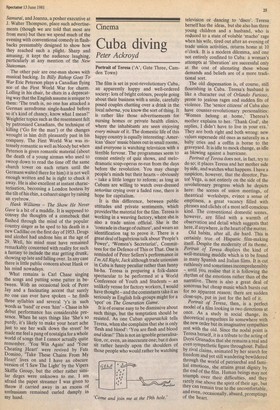Cinema
Cuba diving
Peter Ackroyd
Portrait of Teresa ('A', Gate Three, Camden Town) The film is set in post-revolutionary Cuba, an apparently happy and well-ordered society: lots of bright colours, people going about their business with a smile, carefully posed couples chatting over a drink in the local taberna, you know the sort of thing. It is rather like those advertisements for nursing homes or private health clinics, where the inhabitants are seen enjoying every minute of it. The domestic life of this happy country is equally interesting: American 'disco' music blares out in small rooms, and everyone is watching television with a terrible fervour. The programmes seem to consist entirely of quiz shows, and melodramatic soap-operas re-run from the days before the revolution. You may change people's minds but their hearts — obviously — take a little longer to reform; as long as Cubans are willing to watch over-dressed senoritas crying over a faded rose, there is hope for capitalism. It is this difference, between public attitudes and private sentiments, which provides"the material for the film. Teresa is working in a weaving factory, where she is also a trade union official. She is the 'comrade in charge of culture', and wears an identification tag to prove it. There is a great deal of lugubrious talk about 'People's Power', 'Women's Secretariat', Committees for the Defence of This or That. One is reminded of Peter Sellers's performance in I'm All Right, Jack although trade unionism in Cuba is funny peculiar rather than funny ha-ha. Teresa is preparing a folk-dance spectacular to be performed at a World Conference of Youth and Students — an unlikely venue for factory workers, I would have thought — and the contestants take it as seriously as English folk-groups might for a 'spot' on The Generation Game. It is of course easy to be dismissive about such things, but the temptation should be resisted. As one Cuban apparatchik tells Teresa, when she complains that she is only 'flesh and blood': 'You are flesh and blood and ideas!' This is not an ignoble generalisation, or, even, an inaccurate one; but it does Sit rather heavily upon the shoulders of those people who would rather be watching television oi dancing to 'disco'. Teresa herself has the ideas, but she also has three young children and a husband, who is reduced to a state of voluble 'macho' rage when his wife, tired out after an evening of trade union activities, returns home at 10 o'clock. It is a modern dilemma, and one not entirely confined to Cuba: a woman's attempts at 'liberation' are successful only at the cost of alienating those whose demands and beliefs are of a more traditional sort.
The old dispensation is, of course, still flourishing in Cuba. Teresa's husband is like a character out of Orlando Furioso, prone to jealous rages and sudden fits of violence. The 'senior citizens' of Cuba also have counter-revolutionary personalities: 'Women belong at home,' Theresa's mother explains to her. 'Thank God', she replies, I didn't have to live in your era.' They are both right and both wrong: new values supersede old ones as naturally as a baby cries and a coffin is borne to the graveyard. It is idle to mock change, as idle as blowing against a hurricane.
Portrait of Teresa does not, in fact, try to do so; it places Teresa and her mother side by side, and watches what happens. I have a suspicion, however, that the director, Past& Vega, is not entirely on the side of the revolutionary progress which he depicts here: the scenes of union meetings, of theatrical workshops, evince a sense of emptiness, a great vacancy filled with phrases and clichés of a most self-conscious kind. The conventional domestic scenes, however, are filled with a warmth of observation and detail which suggests that here, if anywhere, is the heart of the matter.
Old habits, after all, die hard. This is certainly true of Hispanic film-making itself. Despite the modernity of its theme, Portrait of Teresa displays the kind of well-meaning muddle which is tO be found in many Spanish and Italian films. It is cut ruthlessly and sometimes incomprehensibly — until you realise that it is following the rhythm of the emotions rather than of the narrative. There is also a great deal of sonorous but cheap music which bursts out for no apparent reason; there are sudden close-ups, put in just for the hell of it. Portrait of Teresa, then, is a perfect model of a film looking in two directions at once. As a study in social change, its theoretical sympathies lie somewhere with the new order but its imaginative sympathies rest with the old. Since the nodal point is Teresa herself, it is a tribute to the acting of Daysi Granados that she remains a real and even sympathetic figure throughout. Pulled by rivalclaims, animated by her search for freedom and yet still wandering bewildered through the world of patriarchal and familial emotions, she attains great dignity by the end of the film. Human beings may not triumph over their difficulties, and they rarely rise above the spirit of their age, but they can remain true to the uncomfortable. and even, occasionally, absurd, promptings of the heart.






































 Previous page
Previous page